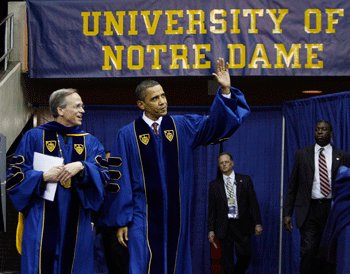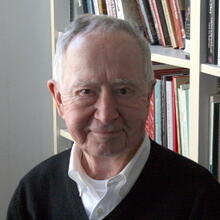We have a Vatican II president. Barack Obama, I am sure, does not think of himself in those terms, but when I heard his speech at Grant Park in Chicago the night he was elected, and more recently his commencement address at Notre Dame, that is what immediately struck me. On those occasions he embodied and professed in his public persona the spirit of the council. In making that statement I know that I am entering a minefield. Catholics who denounce the president for his stance on abortion are of course responsible for many of the mines in the field, but their mines have been so thoroughly discussed lately that for the sake of brevity I will bypass them here.
The other set of mines in the field comes from the expression “the spirit of Vatican II.” The expression, used widely at the time of the council and given a certain official standing at the Synod of Bishops in 1985, has lately in Roman circles been quietly downgraded, if not dismissed as meaningless. No doubt, the expression has been abused to justify interpretations far removed from what the bishops intended, and it has seemed all too prone to ideological manipulation. Your “spirit of the council” is not my “spirit of the council.”
Yet the expression has a legitimate place in our vocabulary and is in fact almost indispensable for grasping the big message the council wanted to deliver. By “the spirit of the council” I mean simply general orientations that transcended particular issues. In my book, What Happened at Vatican II, I argue that beneath the particular issues the council dealt with—episcopal collegiality, for instance, and religious liberty—more profound and far-reaching issues lurked. I call these the issues-under-the-issues. I ground them in the texts of the council and in that way ground “the spirit of the council” and give it verifiable substance.
Among the issues-under-the issues was style, the issue especially pertinent for grounding “the spirit of the council.” The council spoke in a new style, a style different from all previous councils. It eschewed words implying punishment, surveillance, hostility, distrust and coerced behavior-modification that characterized previous councils. It employed words that espoused a new model for Christian behavior—not new, of course, to the Christian tradition as such, but new to council vocabulary. I am referring to words like brothers and sisters, cooperation, partnership, human family, conscience, collegiality and especially dialogue. The new words cannot be dismissed as casual asides or mere window dressing. The council used them too insistently, intentionally and characteristically for them to be that. This new vocabulary made the council a major language-event in the history of the church.
The shift in vocabulary had profound ramifications. It meant a shift in values and priorities. Critical among these new values was civility in dealing with persons of different faiths or convictions and a willingness to listen to them with docile heart and mind. This civility was not a superficial tactic but a manifestation of an inner conversion. It of course did not mean surrendering one’s beliefs, but it did mean a willingness to learn from others and a refusal to condemn them without a hearing. Such openness of mind and heart is the essence of genuine dialogue.
The council hoped that this new style of being, which brings with it a new way of proceeding, would lead to cooperation among all persons of good will—Catholics and non-Catholics, Christians and non-Christians, believers and non-believers—on the new, massive, and sometimes terrifying problems that face humanity today. This new way of proceeding in large part constituted “the spirit of the council.” It was one of the big messages the council delivered to the church and to the world at large.
That is why when I heard Obama’s two speeches I was struck by how much he spoke in accord with the spirit of Vatican II. In those two addresses, as well as in his other speeches, he called for civility, for the end of name-calling, and for a willingness to work together to deal with our common problems, including abortion, rather than a stand-off determination to impose one’s principles without reckoning what the cost to the common good might be.
President Jenkins of Notre Dame called attention to Obama’s oratorical gifts. Such gifts are consonant with the rhetorical tradition that produced the spirit of Vatican II. The council deliberately chose to speak as much as possible “in the pastoral style of the Fathers,” who were schooled from their earliest days in the rhetorical tradition. That tradition is what made them such effective preachers and leaders of their communities.
Classical theorists about rhetoric like Cicero and Quintilian described it as the art of winning consensus, the art of bringing people together for a common cause. It is an art, please note, closely related to ethics, for those same theorists described the truly successful orator as vir bonus dicendi peritus--a good man, skilled in public speaking. It is an art in which Obama excels and which, certainly unwittingly, puts him in touch with the spirit of Vatican II.
I often hear laments that the spirit of Vatican II is dead in the church. Is it not ironic that not a bishop but the President of the United States should today be the most effective spokesperson for that spirit? To judge from the enthusiastic response he received from the graduates at Notre Dame, his message captured their minds and hearts. Maybe through young Catholics like those at Notre Dame who are responding to Obama’s message the spirit of Vatican II will, almost through the back door, reenter the church. The history of the church has, after all, taken stranger turns than that.







